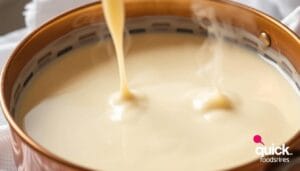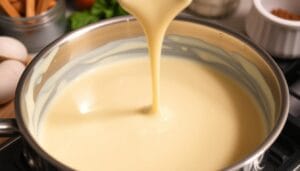Can a simple white sauce take your cooking to new heights? Many chefs and home cooks say yes, thanks to mastering creamy bechamel sauce. This versatile sauce adds richness to dishes like lasagna and mac and cheese.
Making bechamel from scratch might seem hard, but it’s easy with a step-by-step guide. Follow these simple steps to create a deliciously creamy sauce that will be a staple in your kitchen.
Key Takeaways
- Learn the basics of a classic white sauce
- Understand the importance of using quality ingredients
- Follow a simple step-by-step guide to making bechamel sauce
- Discover tips for achieving a creamy texture
- Explore various uses for bechamel sauce in your cooking
What Is Bechamel Sauce?
Bechamel sauce, a key sauce in French cuisine, has been around for centuries. It’s a white sauce made from butter, flour, and milk. This sauce is versatile and the base for many others.
The Mother of All Sauces
Bechamel sauce is a “mother sauce” because it’s a basic sauce for many others. French chef Auguste Escoffier introduced the concept of mother sauces in the late 19th century. Bechamel sauce is used in many dishes, like lasagna and mac and cheese, showing its culinary flexibility.
The beauty of bechamel sauce is its simplicity and adaptability. You can change it up with different seasonings and ingredients to create many flavors.
Historical Origins and Culinary Importance
Bechamel sauce is named after Louis de Béchamel, a French financier. He was a steward to King Louis XIV. The sauce has evolved and is now a key part of French cuisine.
The table below highlights the basic components and variations of bechamel sauce:
| Component | Basic Version | Variations |
| Roux | Butter and Flour | Using different types of fat or gluten-free flour |
| Liquid | Milk | Using cream, vegan milk alternatives, or flavored milks |
| Seasoning | Salt, Nutmeg | Adding cheese, herbs, or spices |
Essential Ingredients for Perfect Bechamel Sauce
The key to a great Bechamel sauce is its simple yet essential ingredients. Knowing these components is vital for making a sauce that’s both authentic and delicious.
Base Ingredients: Flour, Butter and Milk
The basic Bechamel sauce recipe needs three main ingredients: flour, butter, and milk. The flour and butter mix to make a roux, thickening the sauce. Milk is then added slowly, making the sauce smooth and creamy. The quality of these ingredients affects the sauce’s taste and texture.
- All-purpose flour for a smooth roux
- Unsalted butter for richness and flavor
- Whole milk for creaminess
Optional Flavor Enhancers and Seasonings
The basic Bechamel sauce is tasty on its own. But, adding a pinch of nutmeg or some grated cheese can make it even better. For a vegan Bechamel sauce, use plant-based milk and vegan butter. Trying different herbs and spices can also create new Bechamel sauce flavors.
Equipment You’ll Need for Smooth Results
To make bechamel sauce, you need some key tools. You’ll be heating, whisking, and simmering, so having the right equipment is important.
Essential Tools for Success
You’ll start with a medium saucepan for heating the milk and roux. A whisk is key to avoid lumps. Also, a wooden spoon or silicone spatula is useful for stirring and scraping the pan.
- Medium saucepan
- Whisk
- Wooden spoon or silicone spatula
Nice-to-Have Utensils for Convenience
A fine-mesh sieve can help strain the sauce for a smoother texture. A measuring jug is also handy for precise milk measurements.
Making Basic Bechamel Sauce: Step-by-Step Instructions
Bechamel sauce is a key ingredient in many classic dishes. It’s easy to make with basic ingredients and simple steps. You can create a rich, creamy sauce to enhance your cooking.
Preparing the Perfect Roux
The base of a great bechamel sauce is a well-made roux. Start by melting 2 tablespoons of butter in a medium saucepan over medium heat. Then, add 2 tablespoons of all-purpose flour and whisk until smooth and lump-free.
Cook the roux for about 1-2 minutes, stirring constantly. This step is important as it removes the raw flour taste and adds depth to the sauce.
Adding the Milk Gradually
Pour in 1 cup of milk slowly, whisking continuously to prevent lumps. It’s important to add the milk slowly and keep whisking to get a smooth sauce.
Simmer the mixture for about 5-7 minutes, or until it thickens and coats the back of a spoon. Then, remove the saucepan from the heat.
Seasoning and Finishing Touches
Season the bechamel sauce with salt, nutmeg, and a pinch of black pepper to taste. You can also add other flavor enhancers like grated cheese or a sprinkle of paprika, depending on your recipe.
| Ingredient | Quantity | Purpose |
| Butter | 2 tablespoons | Base for roux |
| Flour | 2 tablespoons | Thickening agent |
| Milk | 1 cup | Creates creamy texture |
By following these steps, you’ll be able to make a basic bechamel sauce that’s perfect for dishes like lasagna or mac and cheese. Experiment with different seasonings and flavor combinations to make the sauce your own.
Common Bechamel Sauce Mistakes and How to Fix Them
Bechamel sauce can have common mistakes like lumpy texture, wrong consistency, and flavor imbalances. Knowing how to fix these problems can improve your sauce-making skills.
Solving Lumpy Sauce Problems
Lumps in bechamel sauce are a common issue. They happen when the roux isn’t mixed well with the milk or when milk is added too fast. To avoid lumps, make sure your roux is smooth before adding the milk slowly, whisking constantly. If lumps form, try straining the sauce or whisking it hard to break them down.
For tough lumps, take the sauce off the heat and use an immersion blender. It helps to add the milk at a moderate temperature to prevent lumps.
Fixing Flavor and Consistency Issues
Bechamel sauce can also have flavor and consistency problems. If it’s too thick, add a bit more milk. If it’s too thin, cook it gently while stirring to thicken it. Seasoning is key; a bit of salt or nutmeg can greatly improve the taste.
If the sauce tastes bland, try adding a dash of mustard or a sprinkle of grated cheese to enhance the flavor. Using high-quality ingredients can also make a big difference in taste. By fixing these issues, you can make a smooth, flavorful bechamel sauce that enhances your dishes.
Delicious Variations of Bechamel Sauce
Bechamel sauce is great for making many delicious variations. Its creamy texture makes it a favorite for both chefs and home cooks. It’s easy to adapt to different tastes and dietary needs.
Bechamel Cheese Sauce for Extra Richness
Adding cheese to bechamel sauce makes it richer and more indulgent. You can use Parmesan, Cheddar, or Gruyère cheese. Just grate the cheese and stir it into the sauce until it’s smooth.
- Parmesan adds a salty, umami flavor
- Cheddar contributes a sharp, tangy taste
- Gruyère provides a nutty, slightly sweet flavor
Gluten-Free Bechamel Sauce Options
For those with gluten intolerance or sensitivity, you can make bechamel sauce gluten-free. Use almond flour or rice flour instead of wheat flour. Make sure to adjust the amount of flour to butter to get the right consistency.
Vegan Bechamel Alternatives
Vegan versions of bechamel sauce can be made by using plant-based milks and vegan butter or margarine. Cashew cream is also a great substitute for a creamy texture without dairy. These options let vegans enjoy the rich flavor of bechamel sauce.
- Use plant-based milks like almond or soy milk
- Replace butter with vegan margarine or cashew cream
- Adjust seasoning to taste
Popular Dishes Using Bechamel Sauce
Bechamel sauce elevates many comfort food classics. Its creamy texture is key in many beloved recipes.
Bechamel Sauce for Lasagna
Lasagna is a classic dish that benefits from bechamel sauce. The sauce adds creaminess, balancing the bold flavors of the meat ragù and melted mozzarella. A well-made bechamel sauce can turn a simple lasagna into a gourmet dish.
Bechamel Sauce for Mac and Cheese
Macaroni and cheese is another comfort food that bechamel sauce enhances. It makes the cheese sauce smoother and more velvety, coating the pasta perfectly. This upgrade makes the dish richer and more satisfying.
Pasta Dishes Enhanced with Bechamel
Bechamel sauce isn’t just for lasagna and mac and cheese. It can also enhance various pasta dishes, adding a creamy element that complements tomato or olive oil-based sauces.
Other Classic Applications
Beyond pasta, bechamel sauce is used in many other classic dishes, like croque-monsieur and vegetable gratins. Its versatility makes it a valuable sauce in your kitchen.
Storage and Make-Ahead Tips for Bechamel Sauce
Bechamel sauce is versatile in many recipes. Knowing how to store it properly can make cooking easier. Proper storage lets you prepare it ahead of time without losing its quality.
Refrigerating Bechamel Sauce
To refrigerate bechamel sauce, cool it to room temperature and then put it in an airtight container. It can stay in the fridge for up to 3 days. Always reheat it gently to avoid lumps.
Can You Freeze Bechamel Sauce?
Yes, bechamel sauce can be frozen. Cool it completely before putting it in a freezer-safe container. It can be frozen for up to 3 months. Label the container with the date to keep track of how long it’s been stored.
Reheating Methods for Best Results
To reheat, place the sauce in a saucepan over low heat, whisking constantly. Or, you can reheat it in the microwave in short intervals, stirring between each heating. This keeps the sauce smooth.
Conclusion
Making homemade bechamel sauce is simple and rewarding. It makes dishes like lasagna and mac and cheese better. By following this guide, you can make a smooth, creamy sauce that suits your taste.
A bechamel sauce summary highlights its benefits. It’s a key ingredient in many cuisines, adding richness and creaminess. The bechamel sauce benefits are many, making it a must-have in any kitchen.
With this guide, you can make bechamel sauce from scratch and try different variations. Adding your own twists can create unique recipes. Using homemade bechamel sauce in your cooking will elevate your dishes.
FAQ
What is bechamel sauce used for?
Bechamel sauce is a versatile white sauce used in various dishes, such as lasagna, mac and cheese, and pasta recipes, adding creaminess and flavor.
Can you buy bechamel sauce at the grocery store?
Yes, some grocery stores carry pre-made bechamel sauce or white sauce in their international or gourmet sections, but making it from scratch is easy and recommended.
How to make bechamel sauce?
To make bechamel sauce, start by creating a roux with butter and flour, then gradually add milk, whisking continuously, and season with salt, nutmeg, and other desired flavor enhancers.
What is bechamel sauce made of?
Bechamel sauce is made from a combination of butter, flour, and milk, with optional ingredients like cheese, nutmeg, and herbs added to enhance flavor and versatility.
Can you freeze bechamel sauce?
Yes, bechamel sauce can be frozen, but it’s essential to cool it completely before transferring it to an airtight container or freezer-safe bag to prevent the formation of ice crystals.
How to make the bechamel sauce with cheese?
To make a cheesy bechamel sauce, add grated cheese, such as Parmesan or cheddar, to the sauce after it has thickened, and stir until the cheese is fully melted and incorporated.
Is bechamel sauce gluten-free?
Traditional bechamel sauce is not gluten-free due to the presence of wheat flour, but it can be adapted to be gluten-free by using alternative flours like almond or rice flour.
What is the difference between bechamel sauce and white sauce?
Bechamel sauce and white sauce are often used interchangeably, but bechamel sauce typically refers to a more nuanced and flavorful version, while white sauce is a more general term.
Can bechamel sauce be made vegan?
Yes, you can make vegan bechamel sauce. Just swap dairy milk for plant-based options. Use vegan butter or margarine instead. And don’t forget to adjust the seasoning.



